
When it came time to celebrate the 50th Anniversary of Aerosmith, which formed in Boston 1970, the band wanted to go big—and they wanted to go home. They decided to throw a party with a one-off concert event at their hometown’s Major League Baseball stadium, Fenway Park. Covid delayed the 2020 celebration until September 2022 but didn’t dampen the enthusiasm. When Steven Tyler, Joe Perry, and Aerosmith finally played Fenway, the crowd was record setting, snapping up the most concert tickets sold for a show at the home of the Boston Red Sox.
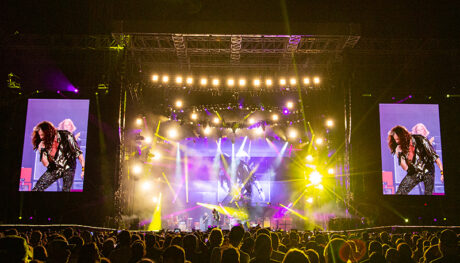
The band’s longtime Lighting Designer, Cosmo Wilson was back behind the console along with Creative Director, Amy Tinkham and Video Director, Jonathan Beswick to put on a modern interpretation of an old-fashioned rock ‘n’ roll concert for all of the fans at Fenway. We caught up with Wilson and Beswick after the event to discuss their work supporting the 50th Anniversary, for which the lighting and video gear was provided by St. Louis, MO-based Gateway Studios & Production Services (GSPS).
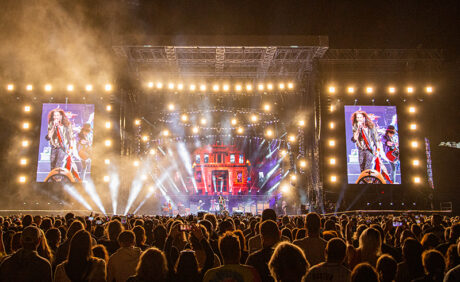
Old School Rock ‘n’ Roll Design
Cosmo wanted to bring an old school rock look to the design for the Fenway Anniversary show. He had done an original design previously for Aerosmith in 2017 when they toured Europe, and it was that design the band asked him to bring back and adapt for Fenway. Also due to a number of reasons, there wouldn’t be the originally planned warm-up shows prior to the Fenway show, other than one night in Bangor, ME to shake everything out. That made the decision to go with Cosmo’s 2017 design a smart move. “I was fine with the design decision for a couple of reasons,” he says. “We hadn’t used it in the U.S., and it was already programmed, which would save a lot of time. We had a lot of time constraints for loading in the show. We had postponed the show a few times and we were up against the baseball schedule at Fenway.”
“I don’t mind reusing designs,” he says. “I did beef up the design because we added the big side wings to the stage, so I added lights. I just wanted the Fenway show to look like an old school rock show. Aerosmith came up in the 70s, in Boston where they started, so I wanted to recreate that old school look that people remember.” Cosmo continues, “I am a PAR can guy, as many people know, and that’s where I started with this design. Ten years ago, I was out with shows that had 500 or 600 PAR cans, but they’re just not practical—or available—these days. Over the past few years, I’ve tried to solve this challenge to give me an old school PAR look but with modern day fixtures. Working with various shops we’ve come up with modern replacements for PAR cans that still give that look and feel to a show. Originally, I decided the [GLP] X4 was the best fixture that looked like a PAR can. I would design with two bars of D type truss with six X4s on them, which morphed to a D type truss with X4s in PAR cans and a [Robe] BMFL on the end of the truss. Now, I’ve gone with Robe LED350s to replace traditional PAR cans. They’re punchy little lights; and I’m really happy with those. They really give me that PAR can look. To replace ACLs, I went with Robe Pointes for that look and overhung them off the top of the truss.”
For audience lights, Cosmo went with Elation CuePix units, “which were great,” he comments. “I also added Robe Fortes over the back video screen and on the floor below the screen. I used [Robe] Spiiders downstage and because Gateway was willing—they’d already bought some Robe LED350s, which I love because they’re more like PAR cans than anything. For ACL replacements the Robe Pointes made sense. It was cost-effective and I had already programmed with the Pointes. I used MegaPointes on the floor for that kind of small beam. I normally use a dozen in what we call the ‘doghouse’ just above the back line, the ramp across the back. I always put 12 lights there and then I put six lights each downstage right and left to fill it out. That just gives a nice floor punch with a fan look. That was a big part of the design because it’s a known design element.”
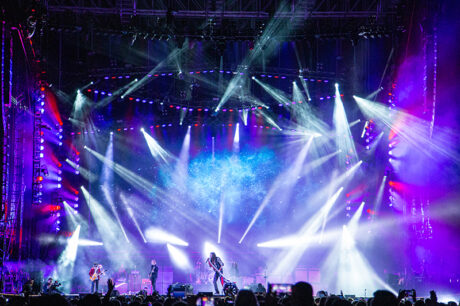
Time Crunch
Even though the show was already programmed, Cosmo did do some additional programming to touch it all up. “They added the Bangor, ME show in there, which was a very smart idea, because it gave us a warmup date right before we got to the big one at Fenway,” explains Cosmo. “Originally, the band was supposed to do some rehearsals in Vegas, and then we were going to do eight shows for the Las Vegas Residency. They canceled that run so there was no rehearsal, no warmup runs, so we went straight into it. I went to Gateway Studios in St. Louis when they were prepping it, and I actually did some previz work there to be prepared.”
It wasn’t until Sunday, Sept. 4, the day of the show in Bangor, that Cosmo saw the complete rig for the first time. “We didn’t even have the night before,” Cosmo comments, “because there was a show in the venue on Saturday night. We loaded in at six o’clock in the morning. I didn’t see the rig until shortly before the show. Everyone knows for any tour it takes a few shows to get everything up to speed, but we didn’t have that luxury. When we were in Boston, I literally didn’t start programming until after midnight. For those guys to get that stuff up and working on the first show, was incredible. You’d be lucky to have that on a tour, much less a one-off.”

Collaborating with the Creative Team
Creative Director, Amy Tinkham “is fantastic,” says Cosmo. “I love her to death. She was great and was very critical in this whole thing because she was the one point of contact for the whole creative team. We also used some of the content that we use in used in Vegas, and it worked quite well.” The team came up with variations on the Aerosmith wings from versions through the band’s 50 years. “We projected the wings below the Green Monster [the imposing left field wall at Fenway] on a kabuki screen,” Cosmo adds. “Also, we took the idea from what we did for Red Alert Restart a few years ago and projected the Aerosmith logo around Boston the day before leading up to the concert to build interest. It was great working with Jonathan [Beswick], he has had a lot of experience with the band over the years and he gets some great shots. He is a great video director.”
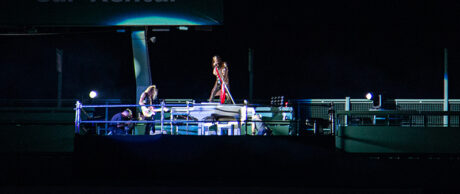
Production Support from GSPS
Gateway Studios and Production Services (GSPS) provided the lighting and video equipment, and crew for this 50th Anniversary show at Fenway Park. Cosmo found the support of GSPS to be “fantastic.” Cosmo works with GSPS, which he says is a bonus. He explains, “William “Stoney” Stonecypher, our Production Manager, who is based in NYC and owns a rigging company, worked a call for a Jack Johnson show at Jones Beach Theatre that GSPS was doing the sound and lighting. Stoney was so impressed with the equipment and the GSPS team, that he called me and said ‘these guys are great’ and wanted them to bid on the Aerosmith show. They did and they got it. Gateway was great to me. They started by saying, ‘what do you need?’ which was great. I always say that it’s more than a team; it’s a family there. Everybody worked hard; it was difficult getting crews since the pandemic and everyone’s busy and a lot of people have dropped out. Lighting crew co-chief Eric “Sluggo” Eaton and Jason “Attaboy” Stalter were critical to the success of these two shows. Attaboy handled a lot of details and paperwork. Sluggo ended up coming to Boston. Our other Lighting Crew Chief was Joel Muir, who was great. He’d worked on Black Pumas for us and did a great job. It was a smaller tour and he’s younger. He felt he didn’t have a lot of experience. I told him not to worry, he had Sluggo behind him. At GSPS, the team in the shop put everything together so well. The entire team, from the project managers on down to the lighting guys in the shop, and the video guys as well—it was a team effort.”
Cosmo also credits his Programmer, Bobby Brooks for his support on the shows. “He’s worked with me, and I asked him to come out and program it. He worked with the team in getting everything up to speed. I like having a programmer for moral support. I don’t want a programmer to sit there and do what I tell them. I want a programmer to have ideas as well; I love the input. They’re not a computer data inputter, but actually need to be thoughtful and I want their input. He was great!”

Video Direction
Video Director Jonathan Beswick, who has worked with Aerosmith off and on since 2004, had been working with the band getting ready for the 2020 Fenway Park anniversary show when Covid shut everything down. When things opened back up there was to be a series of shows to prepare for the big event, but circumstances intervened. “We lost out on our opportunity to warm up and rehearse,” explains Beswick, “so we went into that show in Bangor ME—just a few days before the Fenway show. We went right into that Bangor show, pretty much after two years of the whole crew not doing anything. So, there was quite a bit of spool up and organizational things. We wanted to add things and really make this a very memorable show.”
Aerosmith played Fenway in 2010. “That was a great show for them, but this show was their 50th Anniversary, so it became a little bit more important of an event,” says Beswick. “We geared up and buckled down. Everybody tried to figure out how we were going to pull all this off and what we were going to do. We decided to take some content elements of the residency show. We reproduced the show intro with some pretty cool, never-before-scene, exclusive, archival footage, which was neat to have. Things that the fans had never seen before. Some really cool stuff from way back in the early days was included. That was a great way to start the show.”
Beswick continues, saying that “this band always wants to pull a rabbit out of its hat, so Steven said, ‘you know what? Let’s put the “Dream On” piano up on the Green Monster’. That presented some logistical problems, not only for us trying to figure out how to cover it from a video standpoint and to archive it, which was important, but also just how do we get Joe and Steven up there in time! It’s a pretty good hike of steps.” The creative team came up with this idea of some fireworks behind the Green Monster to draw everyone’s attention to the performance up there when ready. “We ended up placing an additional camera and covered it pretty well. Once Steven started playing, and yelling ‘hey, I’m up over here’ the audience finally realized he was up there. Then when the fireworks went off behind him that got everybody’s attention. That was a cool moment.”
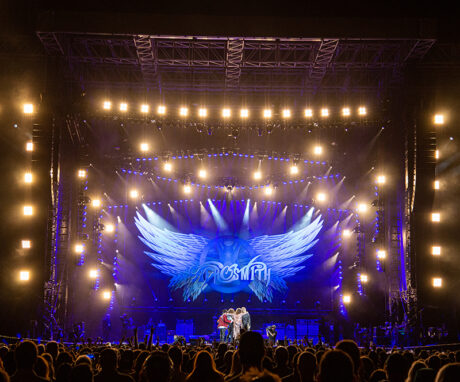
Key Video Gear
The video control system and workflow were pretty straightforward. Beswick says, “We had a disguise media server for playback; everything went through disguise—the upstage wall and the left and right screens. That programming was done by Lance Duvall from Gateway who supplied all of the equipment for the Bangor and Boston shows. My switcher was a 2M/E switcher from Blackmagic Design. I was cutting a pretty straightforward show. There wasn’t a lot of split screening or things like that. There were some overlays and background elements like flames and toys in the attic elements; over and underlays on the I-Mag. The left and right screens were pretty much I-Mag the whole show.”
Beswick enjoyed working with GSPS on this project. “Gateway is a relatively new company; out of St. Louis,” he explains. “All of their systems are brand new 4K stuff. I like Blackmagic gear personally. It’s easy to program, pretty solid reliability-wise, and it does all the things that I need. I’m not super needy as a director, in the sense of gear. I’m lucky that to some degree most of the bands that I personally work with—generally speaking—are legendary acts and most of them just want a really good clean cut on the screens. I’m not splitting images all over the place and trying to do multi-cuts and all that kind of stuff. We did do a little bit of that for the Fenway show.” Due to selling so many seats, the production did add two more I-Mag screens on either side of the stage for the overflow seating.
“The Gateway Studio gear was really good, and they have an excellent team,” notes Beswick. “Kibru Senbetta, who’s the head of the video department over there is a super nice guy. They bent over backwards to send us an extremely talented team of guys that showed up and knocked everything out of the park. They got everything up working quickly, they got everything sized correctly. All the cameras were white balanced and color balanced; all looked exactly the same. The operators that they provided were excellent in their execution of both of those shows.”
Beswick, who has worked alongside Cosmo for years with Aerosmith, feels the Lighting Designer “absolutely, magnificently killed it” with his design for the Fenway Park show. “What an amazing, incredible lighting job he did. From a Video Director’s standpoint, it’s always sometimes a battle with Lighting Directors to make sure you get the right kind of lighting on guys for, whether it’s for the screens or whether it’s for archiving the show. He always provides just an awesome lighting balance between super cool stage lighting and making sure that the artists don’t look like green monsters walking around on stage. You know they have color on them, but they look like rock stars. The cameras read it well, and the balance between the artists and the lighting on the stage was just outstanding. Without his help, and his incredible talent, all the video work that we do would’ve really been for nothing.”
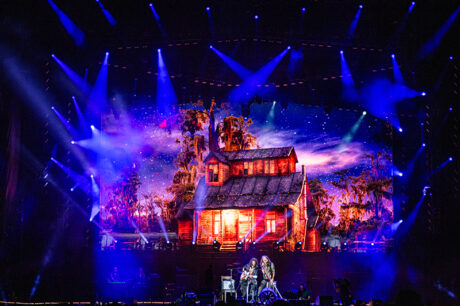
Creative Video Content
On the main upstage screen there were certain video elements, backgrounds, and playback images. “That stuff was pulled from the residency show because it’s extremely well-done content,” continues Beswick. “The content fit with the set list that the team went into the Fenway shows with. “The set list was pretty close to the last show that we played in 2020,” comments Beswick. “From a practical standpoint, that just made sense for the band that they hadn’t played together for two years. They did have a couple of weeks of rehearsals together before we did those two shows.”
“The one thing about Aerosmith that’s kind of really fantastic is they’re still a very dangerous band live. And I mean that in absolutely the most loving sense; they don’t go out there planning everything out,” Beswick feels that’s what’s exciting about Aerosmith. “At this point in their careers, they were on fire at both of these shows. The band itself was playing extremely well and were playing super tight. Steven’s voice was in extremely good condition. When we hit Bangor, and we did a sound check that evening, we all looked at each other and went like, holy f**k! It was great, and Joe was in great form. They were all really in good form.”
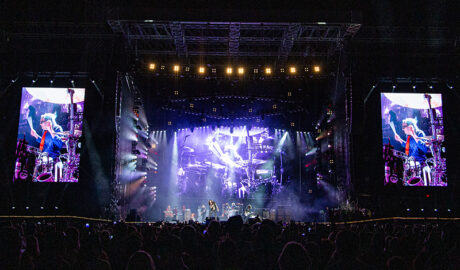
Trust in the Design
Cosmo concludes, by saying “I do want to say the support from Steven Tyler, and the band was incredible, they were 100% behind the design and me. My favorite bands are the ones that just let me do my thing and trust me. I always say ‘the band is paying me, so they don’t have to talk about lights. They concentrate on what they’re doing’. The fact that this band has that much confidence in me, and to allow me to do what I did on one of the most important shows of their career, speaks volumes to me. I look back at that show and it just makes my heart full to think about the support in that way from the band. You can’t ask for anything more than that.”
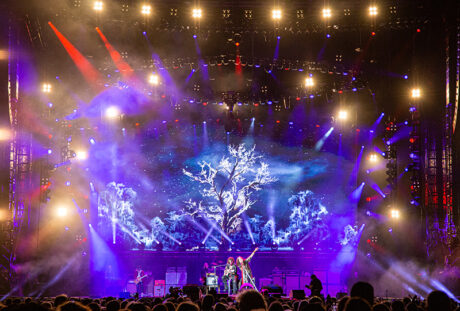
Production Team
- Production Designer: Amy Tinkham
- Lighting Designer/Director: Cosmo Wilson
- Production Manager: William “Stoney” Stonecypher
- Project Manager: Adam Ellis
- Lighting Programmer: Bobby Brooks
- Lighting Crew Chiefs: Eric “Sluggo” Eaton, Joel Muir
- Lighting Techs: Graham “Grum” Hill (Racks & Dimmers), Kevin Lichty,
Dustin Rodriguez, Chaz Malott - Video Content: Olivia Sebesky / Pixomondo
- Intro Video Content Editor: Nick Gartner
- Video Director: Jonathan Beswick
- Video Engineers: Brandon Gallegos, Steve Culpepper
- Media Server Operator: Lance Duvall
- Video Wall Techs: Pat Dolan, Jeff Hoyle, Scott Brown
- Camera Ops: Lari Dolan, Scott Lootens, Bradley Moore, Andy Thompson
- Pyro Head: Peter “Pyro Pete” Cappadocia/ImageSFX
- Pyro Company: Atlas Fireworks/Matthew Shea
- Staging Company: G2 Structures
- Stage Manager: Mike McGovern
- Head Carpenter: Elijah Hodge
- Head Rigger: Jeff Kurtz
- Lighting and Video Vendor: Gateway Studios & Production Services
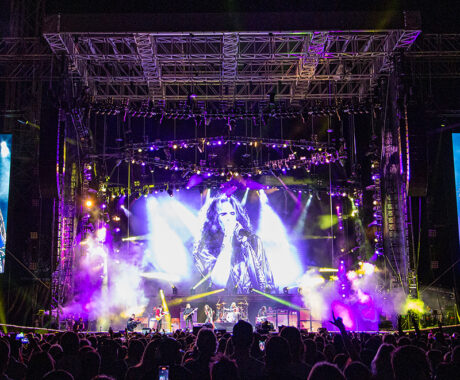
Gear
Lighting
- 1 MA Lighting GrandMA2 full-size console
- 1 MA Lighting GrandMA3 full-size console
- 156 Robe LEDBeam 350
- 40 Robe Pointe
- 24 Robe MegaPointe
- 49 Robe BMFL Wash
- 28 Robe Forte
- 32 Robe Spiider
- 3 Robe Esprite
- 4 Robe BMFL RoboSpot
- 11 GLP JDC1 LED Strobe
- 40 CHAUVET Strike Array 4
- 6 CHAUVET Strike Array 2
- 36 Elation CuePix 16IP
- 1 Elation Arena PAR Zoom Q7IP
- 4 MDG TheOne Dual Hazer Fogger
- 4 hazebase Base Hazer Pro Hazer
- 40 CM Prostar 1-Ton Hoist
- 2 CM Prostar 1/2-Ton Hoist
- 47 8’ Tyler Truss GT Truss
- 8 10’ Tyler Truss GT Truss
- 14 10’ Tyler Truss 12”x12” Box Truss
- 2 8’ Tyler Truss 12”x12” Box Truss
- 5 5’ Tyler Truss 12”x12” Box Truss
Video
- 1 Blackmagic Design 2ME 4K Flypack System
- 1 disguise Media Server
- 6 Panasonic AK-UC3000GS 4k Studio Camera
- 2 Panasonic AW-UE150KPJ 4K PTZ Camera
- 1 ROE Visual CB5 Upstage Screen, 51’-2”W x 29’-6”H
- 2 ROE Visual CB5 L&R I-Mag Screens, 19’-8”W x 29’-6”H
- 2 Side LED Screens for Overflow Seats
PLSN thanks Gateway Studios & Production Services for their help bringing this coverage to our readers.


